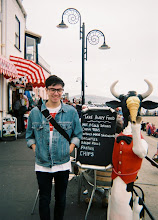Following on from my previous attempt to film flowers in the dark with a hotshoe flash I decided to go for a more controlled set-up. I had learned from my previous experiments with this technique that the results were tempermental at best, often the video camera would not catch the flash at all, leaving an entirely black screen, other times the frame would only be half-exposed. As well as this there were problems when transferring from the tape to the mac, often frames shot at a high shutter speed are skipped over and, as each flash is only a few hundredths of a second this means that no image appears in the shot at all.
To ensure atleast some video footage I decided to shoot at all the speeds available on the camera, from 1/50th to 1/2000th of a second. I also used a reflector so as to bounce more light back into the shot and hopefully give a more professional look to the shots. A great drawback when shooting at such high speeds and relying on an exposure which is barely registered by the naked eye is that, without a slow-motion playback setting on the camera the results cannot be seen or any problems rectified until played back in the edit-suite. With the method I employed I was more or less shooting blind.
The video below is the edited results of this experiment. Many of the shots did not work the way I had planned, common problems were the changing colour of the shots, the splitting of shots into upper and lower frames, as can be seen in the first two attempts, and the amount of static shots which this method leads to.
To ensure atleast some video footage I decided to shoot at all the speeds available on the camera, from 1/50th to 1/2000th of a second. I also used a reflector so as to bounce more light back into the shot and hopefully give a more professional look to the shots. A great drawback when shooting at such high speeds and relying on an exposure which is barely registered by the naked eye is that, without a slow-motion playback setting on the camera the results cannot be seen or any problems rectified until played back in the edit-suite. With the method I employed I was more or less shooting blind.
The video below is the edited results of this experiment. Many of the shots did not work the way I had planned, common problems were the changing colour of the shots, the splitting of shots into upper and lower frames, as can be seen in the first two attempts, and the amount of static shots which this method leads to.
I have also begun working on a sound-scape which should hopefully hold the film together and add more action or intrigue. I also intend to cut down some of the shots, particularly the long static shots of the plants lit against the background. I intend to re-shoot this in the studio, however do not expect greatly improved results and so, as an alternative to this, will begin to look at shooting more well-lit images, not lit by a flash, and playing them back in slowmotion so as to still link to this. Again Zabriskie Point will be a referrence for this. I also intend to continue with the idea of the fragile made solid by playing with the audio track for this idea, the idea I have, though quite trite and cliched, is the use of a sound-scape made from the noises of glass played whilst flowers fall in slow-motion. Though I do not intend to continue this as my final piece I feel it is a valuable stepping stone towards some sort of resolution of this project.

No comments:
Post a Comment